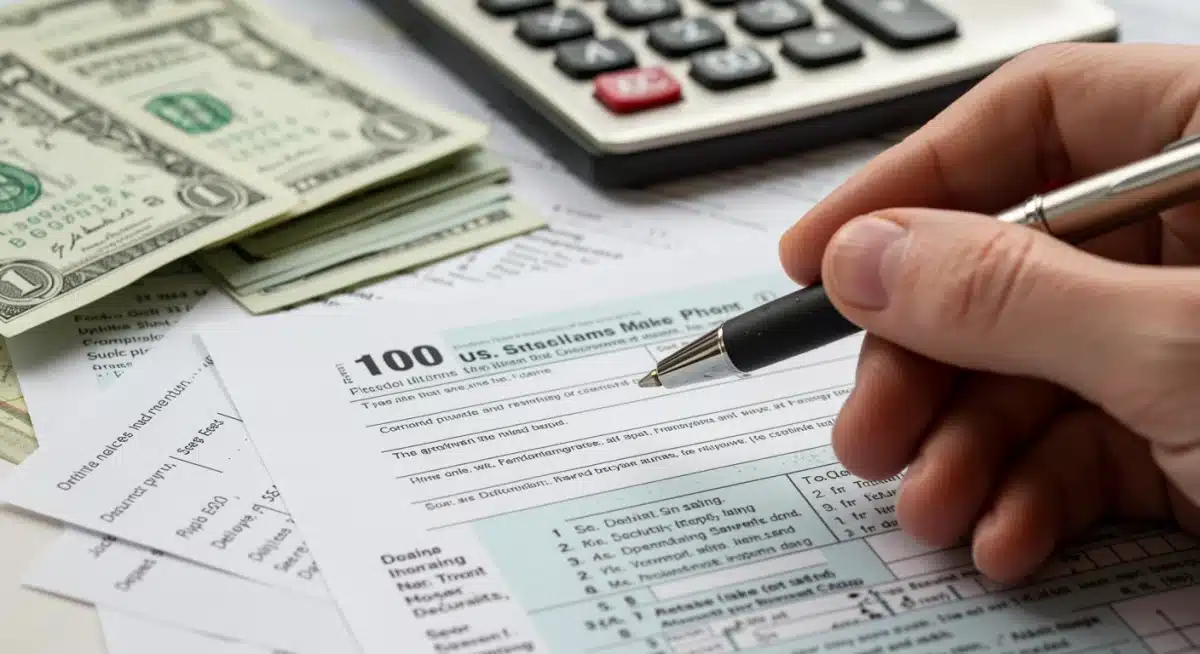2025 Tax Code Changes: Optimize Deductions by 15%

Understanding the upcoming 2025 tax code changes is crucial for American savers to proactively implement strategies that can optimize deductions and potentially lead to a 15% reduction in their tax burden.
As the calendar turns towards 2025, American savers face a landscape of evolving tax regulations. Effectively navigating the 2025 tax code changes: 3 key strategies for American savers to optimize deductions by 15% is not just about compliance, but about seizing opportunities to enhance your financial well-being. This guide aims to equip you with the knowledge and actionable steps needed to confidently approach the new tax year.
Understanding the Landscape of 2025 Tax Changes
The year 2025 brings with it a series of adjustments to the U.S. tax code, some of which could significantly impact individual and family finances. These changes are often driven by economic shifts, legislative priorities, and a continuous effort to refine the nation’s fiscal policies. Staying informed about these modifications is the first step towards effective tax planning and maximizing your financial advantages.
Many of these impending changes stem from the expiration of certain provisions from the Tax Cuts and Jobs Act (TCJA) of 2017, alongside new legislative initiatives. Understanding the nuances of these shifts is paramount for any diligent saver looking to protect their income and grow their wealth. The impact can vary greatly depending on income level, family structure, and specific financial habits.
Key areas of tax code evolution
- Individual income tax rates: Several marginal tax rates are slated for adjustment, potentially affecting how much of your income is taxed at different brackets.
- Standard deduction amounts: The standard deduction, a popular choice for many taxpayers, is expected to see revisions, which could influence whether itemizing remains beneficial.
- Child tax credit modifications: Eligibility and credit amounts for the child tax credit may undergo changes, impacting families with children.
- Estate and gift tax exemptions: High-net-worth individuals should pay close attention to potential alterations in estate and gift tax exemptions.
These adjustments collectively shape the environment in which you will be filing your taxes. Proactive analysis of these changes allows you to anticipate their effects and adapt your financial strategies accordingly. Ignoring them could lead to missed opportunities for significant tax savings.
In essence, the 2025 tax landscape is dynamic. It demands attention and a willingness to adapt. By grasping the fundamental shifts, you position yourself to make informed decisions that can lead to substantial financial benefits.
Strategy 1: Maximizing Retirement Account Contributions
One of the most effective ways for American savers to optimize deductions is by strategically utilizing retirement accounts. These vehicles offer powerful tax advantages, often allowing contributions to be deducted from current income, thereby reducing your taxable income for the year. As we approach 2025, understanding the updated contribution limits and rules for various retirement plans becomes even more critical.
Traditional IRAs and 401(k)s are cornerstone tools for tax-advantaged savings. Contributions to these accounts are typically pre-tax, meaning they reduce your adjusted gross income (AGI) in the year they are made. This immediate tax benefit can be substantial, especially for those in higher tax brackets. The money then grows tax-deferred until retirement, when withdrawals are taxed as ordinary income.
Understanding IRA and 401(k) limits
For 2025, it is essential to be aware of any new contribution limits set by the IRS. These limits are periodically adjusted for inflation, and exceeding them can lead to penalties. Maximizing your contributions up to these limits is a straightforward path to reducing your current tax burden while simultaneously building a secure financial future. For those age 50 and over, additional catch-up contributions are often permitted, providing an extra opportunity for tax-deferred savings.
- Traditional IRA contributions: Ensure you are contributing the maximum allowable amount, especially if you qualify for a full deduction.
- 401(k) and 403(b) plans: If your employer offers a retirement plan, contribute at least enough to receive any matching contributions, which is essentially free money. Beyond that, aim to max out your contributions to reduce your taxable income.
- Catch-up contributions: Don’t overlook the additional amounts you can contribute if you are 50 or older, as these significantly boost your tax-advantaged savings.
The beauty of these accounts lies not only in the immediate tax deduction but also in the power of compound interest working within a tax-deferred environment. This allows your investments to grow more rapidly over time, unhindered by annual tax obligations on gains. By prioritizing these contributions, you are not just saving for retirement; you are actively engaging in smart tax planning.
In summary, fully leveraging your retirement accounts is a fundamental strategy for optimizing your tax deductions in 2025. Stay informed about the latest contribution limits and make these contributions a priority in your financial plan.
Strategy 2: Strategic Use of Health Savings Accounts (HSAs)
For American savers enrolled in high-deductible health plans (HDHPs), Health Savings Accounts (HSAs) represent a powerful, triple-tax-advantaged savings vehicle. In the context of 2025 tax planning, understanding and maximizing your HSA contributions can lead to significant deductions and long-term financial benefits. HSAs are not just for health care expenses; they are also a potent retirement savings tool.
The triple tax advantage of an HSA is unparalleled: contributions are tax-deductible, earnings grow tax-free, and qualified withdrawals are also tax-free. This combination makes HSAs an exceptionally efficient way to save for medical expenses, both current and future, while simultaneously reducing your taxable income for the year. As healthcare costs continue to rise, the value of an HSA as a tax-efficient savings tool only increases.
Eligibility and contribution limits for HSAs
To contribute to an HSA, you must be covered by an HDHP and not be enrolled in Medicare. For 2025, it is crucial to verify the updated HDHP deductible and out-of-pocket maximums, as well as the HSA contribution limits. These limits are adjusted annually and determine how much you can contribute for both individual and family coverage.
- Verify HDHP status: Ensure your health insurance plan meets the IRS’s definition of a high-deductible health plan for 2025.
- Maximize contributions: Aim to contribute the maximum allowable amount to your HSA. This directly reduces your taxable income.
- Catch-up contributions (age 55+): If you are 55 or older, you can make additional catch-up contributions, further boosting your tax savings and health care fund.
Many individuals use their HSAs solely for immediate medical expenses. However, for those who can afford to pay for current medical costs out-of-pocket, letting HSA funds grow untouched provides an incredible long-term investment opportunity. The funds can be invested in a variety of options, similar to a 401(k), allowing for substantial growth over decades.
Once you reach age 65, HSA funds can be withdrawn for any purpose without penalty, though non-medical withdrawals will be taxed as ordinary income, similar to a traditional IRA. This flexibility makes the HSA a highly versatile component of a comprehensive financial strategy. Leveraging your HSA effectively in 2025 is a smart move for both your health and your wealth.
Strategy 3: Optimizing Itemized Deductions vs. Standard Deduction
One of the perennial decisions for American taxpayers is whether to take the standard deduction or itemize their deductions. In 2025, with potential adjustments to both the standard deduction amounts and the rules governing certain itemized deductions, this decision will be as critical as ever. Strategic analysis can reveal significant opportunities to optimize your tax position and reduce your overall tax liability.
The standard deduction is a fixed amount that taxpayers can subtract from their adjusted gross income (AGI), simplifying the tax filing process for many. Itemized deductions, on the other hand, allow taxpayers to list specific expenses, such as mortgage interest, state and local taxes (SALT), medical expenses, and charitable contributions. The goal is to choose the option that results in the lowest taxable income.
Key itemized deductions to consider
For 2025, it’s vital to track all potential itemized deductions meticulously. Even with a potentially higher standard deduction, a combination of significant expenses could still make itemizing more advantageous. The SALT cap, for instance, has been a contentious point, and any future adjustments could significantly impact high-tax-state residents.
- Mortgage interest: If you own a home and pay substantial mortgage interest, this is often a major component of itemized deductions.
- State and local taxes (SALT): While capped at $10,000 for many years, any changes to this cap would have a profound impact. Even with the cap, for some, this deduction is still significant.
- Medical expenses: If your unreimbursed medical expenses exceed a certain percentage of your AGI, they can be itemized. Keep meticulous records of all healthcare costs.
- Charitable contributions: Donations to qualified charities are deductible. Consider “bunching” donations into one year to exceed the standard deduction threshold.

The key to optimizing here is careful record-keeping throughout the year. Maintain organized files of all receipts and statements for potential deductions. As the year progresses, you can estimate your total itemized deductions and compare them against the projected 2025 standard deduction for your filing status. This proactive approach ensures you’re prepared to make the most advantageous choice when tax season arrives.
Ultimately, the decision between standard and itemized deductions requires a personalized assessment. Don’t assume one is always better than the other; instead, crunch the numbers based on your unique financial situation and the latest tax code provisions for 2025.
Proactive Tax Planning: Beyond Deductions
While optimizing deductions is a cornerstone of smart tax planning, a truly comprehensive approach extends beyond simply reducing taxable income. Proactive tax planning for 2025 involves a holistic review of your entire financial picture to ensure you are positioned for maximum efficiency and long-term growth. This includes considering tax credits, investment strategies, and potential future legislative changes.
Tax credits, unlike deductions, directly reduce your tax liability dollar-for-dollar. They are often more valuable than deductions and should be a key focus in your planning. Familiarize yourself with credits you might qualify for, such as the Child Tax Credit, Earned Income Tax Credit, or various education credits. Eligibility requirements and credit amounts can change, so staying updated is crucial.
Investment strategies for tax efficiency
Your investment portfolio also plays a significant role in tax planning. Understanding the tax implications of different investment vehicles and strategies can help you minimize capital gains taxes and maximize returns. This includes considering tax-loss harvesting, utilizing municipal bonds, and strategically placing assets in tax-advantaged accounts.
- Tax-loss harvesting: Selling investments at a loss to offset capital gains and potentially a portion of ordinary income.
- Municipal bonds: Interest earned on municipal bonds is often exempt from federal income tax, and sometimes state and local taxes as well, making them attractive for high-income earners.
- Asset location: Strategically placing tax-inefficient assets (like high-dividend stocks or REITs) in tax-advantaged accounts (like IRAs or 401(k)s) and tax-efficient assets (like growth stocks) in taxable accounts.
Furthermore, staying abreast of potential future legislative changes is vital. Tax laws are not static, and what is beneficial today might change tomorrow. Engaging with a qualified financial advisor or tax professional can provide invaluable insights and help you navigate these complexities. They can offer personalized advice tailored to your specific circumstances and help you identify opportunities you might otherwise miss.
In conclusion, proactive tax planning for 2025 is about more than just finding deductions. It’s about a strategic, forward-looking approach that integrates tax credits, investment decisions, and ongoing vigilance to legislative developments, ensuring your financial plan remains robust and tax-efficient.
The Importance of Professional Guidance for 2025 Taxes
While understanding the 2025 tax code changes and implementing key strategies is empowering, the complexity of tax law often necessitates professional guidance. For American savers aiming to truly optimize deductions by 15% or more, consulting with a qualified tax professional or financial advisor can be an invaluable investment. Their expertise can uncover opportunities and prevent pitfalls that might be overlooked by even the most diligent individual.
Tax laws are intricate and constantly evolving. What seems like a minor detail can have significant tax implications. A professional can provide a personalized assessment of your financial situation, taking into account your income, investments, family structure, and future goals. This tailored advice is far more effective than generic strategies and can lead to more substantial savings.
Benefits of expert tax advice
Engaging a tax professional offers several distinct advantages, particularly when navigating a new tax year with significant changes. They possess a deep understanding of the regulations and can interpret how these apply to your unique circumstances.
- Personalized strategy development: Professionals can craft a tax plan specifically designed to meet your financial objectives and minimize your tax burden.
- Identification of overlooked deductions and credits: They are adept at finding eligible deductions and credits that you might not be aware of, maximizing your savings.
- Compliance assurance: Ensuring your tax filings are accurate and compliant with all IRS regulations, reducing the risk of audits or penalties.
- Future planning: Offering insights into how current decisions will impact your long-term financial health and future tax liabilities.
Beyond simply filing your taxes, a good tax advisor can help you make informed financial decisions throughout the year. They can advise on investment choices, retirement planning, charitable giving strategies, and even major life events like buying a home or starting a business, all with an eye towards tax efficiency.
Therefore, as you prepare for the 2025 tax season, consider the significant value that professional guidance can add. It’s an investment that can pay dividends in the form of reduced tax liability, peace of mind, and a more secure financial future. Don’t hesitate to seek out an expert to help you confidently navigate the complexities of the tax code.
Key Takeaways for American Savers in 2025
As American savers prepare for the 2025 tax season, a clear understanding of the evolving tax landscape and a proactive approach to financial planning are paramount. The goal is not merely to comply with regulations, but to strategically leverage the available tools to optimize deductions and enhance overall financial well-being. By focusing on key areas, individuals can significantly impact their tax liability.
The three core strategies discussed—maximizing retirement contributions, judiciously using Health Savings Accounts, and carefully comparing itemized versus standard deductions—form a robust framework for reducing your taxable income. Each of these strategies, when implemented thoughtfully, offers distinct advantages that can collectively lead to substantial savings and a stronger financial position.
Recap of essential actions
To summarize, here are the critical actions American savers should prioritize as they look towards 2025:
- Stay informed: Continuously monitor official IRS updates and reputable financial news sources for the latest changes to tax laws and limits.
- Review retirement plans: Maximize contributions to 401(k)s and IRAs, taking advantage of any catch-up provisions if eligible.
- Utilize HSAs: If you have an HDHP, contribute the maximum allowable to your HSA for its unique triple-tax advantage.
- Track deductions: Meticulously record all potential itemized deductions throughout the year to make an informed decision between itemizing and taking the standard deduction.
- Seek professional advice: Consider consulting a tax professional for personalized guidance, especially with complex financial situations.
Beyond these immediate steps, adopting a mindset of continuous financial review and adjustment is key. Tax planning is not a one-time annual event but an ongoing process that adapts to life changes and legislative shifts. By taking these steps, American savers can confidently navigate the 2025 tax code, optimize their deductions, and work towards a more prosperous future.
Embracing a proactive stance on tax planning will not only help you meet your financial goals but also ensure you are making the most of every dollar earned, contributing to long-term financial security and growth.
| Key Strategy | Brief Description |
|---|---|
| Maximize Retirement Contributions | Utilize Traditional IRAs and 401(k)s to reduce taxable income and grow savings tax-deferred. |
| Strategic Use of HSAs | Leverage triple-tax-advantaged Health Savings Accounts for medical expenses and retirement. |
| Optimize Itemized Deductions | Carefully track expenses like mortgage interest, SALT, and charitable giving to potentially exceed the standard deduction. |
| Seek Professional Guidance | Consult a tax expert for personalized advice and to identify all eligible deductions and credits. |
Frequently Asked Questions About 2025 Tax Changes
The biggest changes expected in 2025 largely involve the expiration of certain provisions from the TCJA of 2017. This could lead to adjustments in individual income tax rates, standard deduction amounts, and potentially modifications to credits like the Child Tax Credit, impacting many American households.
Contributions to traditional retirement accounts like 401(k)s and IRAs are typically made with pre-tax dollars. This means the amount you contribute is deducted from your taxable income for the year, effectively lowering your adjusted gross income and, consequently, your tax liability.
HSAs offer a triple tax advantage: contributions are tax-deductible, earnings grow tax-free, and qualified withdrawals for medical expenses are also tax-free. This makes them an excellent tool for both short-term healthcare costs and long-term retirement savings, reducing your overall tax burden.
The choice between itemizing and taking the standard deduction depends on your individual financial situation. You should itemize if your total eligible itemized deductions (e.g., mortgage interest, state and local taxes, charitable contributions) exceed the standard deduction amount for your filing status. Careful record-keeping is key.
It is advisable to seek professional tax advice if you have complex financial situations, significant life changes (marriage, new home, new business), or if you simply want to ensure you are maximizing all possible deductions and credits. A professional can provide personalized strategies.
Conclusion
Navigating the 2025 tax code changes: 3 key strategies for American savers to optimize deductions by 15% is more than a recommendation; it’s a financial imperative for those looking to secure and grow their wealth. By consistently staying informed about legislative updates, proactively maximizing contributions to retirement and health savings accounts, and meticulously tracking potential itemized deductions, individuals can significantly impact their tax liability. The landscape of taxation is always shifting, and embracing a strategic, informed approach, ideally with professional guidance, will ensure that you are not just compliant, but truly optimized for financial success in the coming year and beyond.





